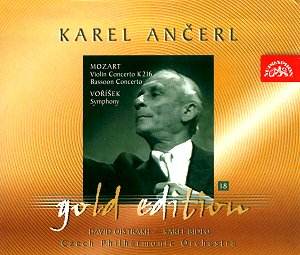Karel
Ančerl was poised for a wonderful career as a conductor when
World War II sent him on a detour to Terezín and Auschwitz where
he managed to survive but lost his family. After the war he continued
to conduct, but his rise to fame didn’t begin until he was appointed
the artistic director of the Czech Philharmonic Orchestra in 1950.
Ančerl took his orchestra to the heights
of international acclaim for a period of 18 years at which time
he decided to emigrate because of the events of 1968. He then
became Chief Conductor of the Toronto Symphony Orchestra, and
North America gained one of the greatest conductors of the 20th
Century.
The
Karl Ančerl "Gold Edition"
consists of 42 volumes, of which the present disc is Volume 18.
The performances are of previously released material that has
been remastered and now sounds less shrill and wider in dimension
than on earlier transfers.
Mozart
needs no introduction, but Vorišek is now a relatively obscure
composer who practised his art during the transitional period
between the Classical and Romantic eras. Born in Bohemia the same
year that Mozart died, Vorišek also had the same life span. He
came from a musical family and went to the University of Prague
in 1810. However, Vienna was the best spot for a composer at that
time, and Vorišek joined many other Bohemian composers in 1813
in this great cultural enclave. He enjoyed an excellent career
in Vienna as a conductor and keyboard performer. Most recordings
of his music are devoted to his solo keyboard works, but there
have been a few recordings over the years of his four-movement
Symphony in D minor.
Although
Vorišek has sometimes been linked musically to Mozart and Haydn,
his Symphony in D minor clearly looks toward Beethoven for inspiration
in its power, angst, and sudden turns in emotional content. This
is not a masterpiece for the ages, but an exceptionally well crafted
symphony with a fine mix of poignancy and high drama.
There
have been two recordings of recent vintage of the Symphony in
D minor. One is from Sir Charles Mackerras on Hyperion, while
the other is from Paul Freeman on Cédille. The Mackerras,
although finely played, tends to look backward to Mozart. Freeman’s
performance is superior as it fully conveys Beethoven’s influence
and is more dramatic with more punch than the Mackerras.
Ančerl’s
interpretation is very much in spirit with Freeman’s. I don’t
want to knock Freeman at all, because his performance of the Symphony
is excellent in all respects. However, he just can’t measure up
to Ančerl who gives the three “Allegro” movements greater
tension and abandon. Particularly stunning is the Trio of the
3rd Movement Scherzo where Ančerl takes a simple
pastoral scene and lifts it into a spiritual quest. Freeman only
offers the simple pastoral scene.
The
2nd Movement Andante also shows Ančerl to be in
command. The music has a mix of yearning and quiet satisfaction
that Ančerl stretches through a slower tempo than used by
Freeman. The way Ančerl gets his strings to incisively lengthen
the most poignant moments is especially compelling, and his entire
interpretation and execution of the Symphony in D minor is outstanding.
Mozart’s
Violin Concerto in G major has received many superb past recordings,
and Ančerl’s is right up there with the best. Partnered by
the legendary David Oistrakh, the performance is on the rugged
and serious side with Oistrakh giving a relatively sharp and sinewy
interpretation. In contrast, the exceptional Stern/Szell performance
is rich and very optimistic in presentation with Stern displaying
a sweet and full violin sound. The 3rd Movement Rondo
finds Ančerl and Oistrakh giving scintillating interpretations;
the excitement Oistrakh creates with his sharply phrased and energized
lines is magnificent and worth the price of the disc on its own.
In
Mozart’s Bassoon Concerto, Ančerl’s outer movements are more
sharply etched than Abbado’s, and Ančerl generates significantly
more tension. However, Karel Bidlo can’t match the dual qualities
of melancholy and optimism possessed by Willard Elliot in the
2nd movement Andante that is one of my favorite Mozart
creations. I am very particular about the bassoon part of this
movement and think that Elliot’s limpid tones are spiritually
uplifting. Overall let’s call it draw, because both versions of
the Bassoon Concerto are exceptional.
In
conclusion, over 70 minutes of great music-making is what you
get with this superb Karel Ančerl volume of his “Gold Series”.
The only question is whether those who already own previous transfers
of the performances will derive net benefits from plunking down
the cash for the disc. I can’t answer that question definitively,
preferences in sound being so personal in nature. What I can assure
readers is that the remastered sound has a bloom largely missing
in past reincarnations that gives the performances an added dimension.
This isn’t a major bloom, but I can notice it. Dedicated Ančerl
enthusiasts will want the new recording, and I am pleased as punch
to have a copy of my own.
Don
Satz

![]() Czech Philharmonic Orchestra/Karel
Ančerl
Czech Philharmonic Orchestra/Karel
Ančerl ![]() SUPRAPHON SU 3678-2
001 [71:27]
SUPRAPHON SU 3678-2
001 [71:27]